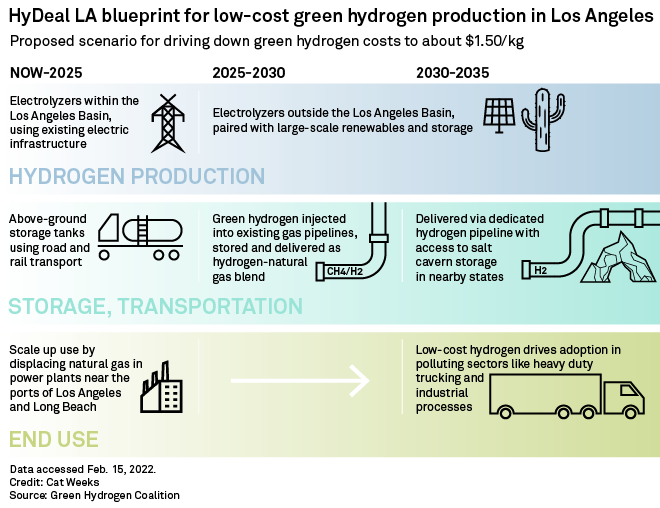S&P Global Offerings
Featured Topics
Featured Products
Events
S&P Global Offerings
Featured Topics
Featured Products
Events
S&P Global Offerings
Featured Topics
Featured Products
Events
Banking & Capital Markets
Economy & Finance
Energy Transition & Sustainability
Technology & Innovation
Podcasts & Newsletters
Banking & Capital Markets
Economy & Finance
Energy Transition & Sustainability
Technology & Innovation
Podcasts & Newsletters
S&P Global Offerings
Featured Topics
Featured Products
Events
17 Feb, 2022
Southern California Gas Co. will seek to develop the nation's largest green hydrogen infrastructure system, a key part of a plan to establish a green hydrogen hub in the Los Angeles area.
The proposed Angeles Link would deliver volumes of green hydrogen equal to nearly 25% of the natural gas currently distributed by SoCalGas, the nation's largest gas utility by customer count. The Sempra subsidiary said the project could significantly reduce demand for natural gas, diesel and other fossil fuels across the Los Angeles Basin.
"The challenges we face on climate require solutions of scale and urgency," SoCalGas CEO Scott Drury said in a Feb. 17 news release. "The Angeles Link is designed to meet those challenges head-on."
Key link in green hydrogen hub
SoCalGas and a consortium of hydrogen stakeholders in May 2021 announced plans to develop the nation's first hub for green hydrogen production and consumption, known as HyDeal LA. Green hydrogen is produced by using zero-carbon electric power to split water into hydrogen and oxygen. Unlike natural gas and other fossil fuels, hydrogen does not release carbon when consumed.
In September 2021, the HyDeal LA partners outlined a vision that includes blending hydrogen produced outside the Los Angeles Basin with natural gas in existing infrastructure beginning around 2025. The hub would shift to using dedicated hydrogen pipelines and salt caverns,

Currently, SoCalGas envisions Angeles Link as a pure hydrogen pipeline focused on meeting industrial demand, according to Neil Navin, vice president for clean energy innovations at SoCalGas.
The intrastate line would deliver green hydrogen produced from large in-state renewable installations east of Los Angeles, such as solar farms in the San Joaquin Valley deserts, Navin said in an interview. Those facilities are capable of producing high-purity hydrogen at scale, Navin said.
"Infrastructure projects like Angeles Link are critical to realizing the green hydrogen vision we developed in HyDeal LA because it will enable low delivered cost for large-scale users across multiple sectors," Green Hydrogen Coalition President and founder Janice Lin said in the release.
Decarbonizing the Los Angeles Basin
The anchor consumers for HyDeal LA's green hydrogen supply are four natural gas-fired power plants previously slated for retirement. As the price of green hydrogen falls toward the target of $1.50/kilogram, the partners expect additional demand to develop among industrial customers with hard-to-electrify processes and heavy-duty trucks, particularly around the ports of Los Angeles and Long Beach.
Among the project's impacts, SoCalGas said the Angeles Link stands to displace 3 million gallons of diesel fuel per day and eliminate nearly 25,000 tons of nitrogen oxide pollution per year. Combined with other clean energy projects, SoCalGas said that the Angeles Link could reduce natural gas demand enough to allow the utility to retire its Aliso Canyon natural gas storage facility, the site of a massive, prolonged gas leak several years ago.
The proposal drew support from state and local politicians, labor and business groups and other stakeholders.
"If we are going to be successful in tackling the climate emergency, we need every company, every worker and every community on the front lines," California Senate Majority Leader Emeritus Bob Hertzberg said in the release. "This effort to establish a green hydrogen energy system in the Los Angeles basin is a creative and inventive step forward in that fight."
Multiyear development process lies ahead
HyDeal partners mapped out about $7 billion in hydrogen pipeline and compression investment by utilities through 2030, but Navin said the total budget for Angeles Link remains unclear. "It will be a large project. I don't think we know exactly today how large. That really depends on the routes. But we do know that it'll be a sizable investment," he said.
SoCalGas filed an application with the California Public Utilities Commission on Feb. 17 to track Angeles Link project development costs. SoCalGas is also seeking permission to embark on initial project studies, including preliminary engineering, assessments of hydrogen supply and off-taker needs and initial stakeholder engagement, Navin said.
The application proposed a phased development approach, with stakeholder engagement at each phase. Subsequent stages will require regulatory review and discretionary approvals, SoCalGas said.
Front-end engineering design would take place in phase two, leading to a more detailed project proposal in phase three, during which SoCalGas would prepare to file for a Certificate of Public Convenience and Necessity, Navin said. Each phase typically takes 12 to 18 months, he said.
In determining who pays for the infrastructure through ratemaking, Navin said customers who consume the hydrogen will likely provide a significant part of the compensation, following a review of how the project benefits spread and accrue among customers.
